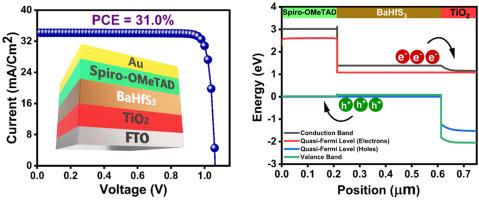漂移-扩散建模引导的BaHfS3硫系钙钛矿太阳能电池界面优化
IF 6.3
2区 材料科学
Q2 ENERGY & FUELS
引用次数: 0
摘要
硫系钙钛矿由于其固有的稳定性、无毒性和良好的光电性能而成为下一代光伏电池的有前途的光吸收剂。为了评估它们的潜力,对6种代表性化合物进行了太阳能电池电容模拟器-一维(SCAPS-1D)漂移扩散模拟,以评估电荷输运特性。BaHfS3表现出最高的载流子迁移率、最长的扩散长度和最强的光吸收。基于bahfs3的钙钛矿太阳能电池(PSCs)在包含六个不同电子和空穴传输层(ETLs和HTLs)的n-i-p结构中建模,以研究界面能级排列。二氧化钛(TiO2)的导带偏置(CBO)和价带偏置(VBO)分别为0 eV和1.9 eV, 2,2,7,7-四基(N,N-二对甲氧基苯胺)-9,9螺芴(Spiro-OMeTAD)的VBO和CBO分别为0.1 eV和1.8 eV,具有较好的空穴提取效率。进一步优化发现,1.0 μm厚的钙钛矿层、1018 ~ 1020 cm−3的掺杂浓度和低缺陷密度(1014 cm−3)显著抑制了复合。此外,减少串联电阻(2 Ω cm2)和增加分流电阻(>1000 Ω cm2)显着提高了性能。阻抗和电容分析证实了优异的界面质量,TiO2/BaHfS3/Spiro-OMeTAD结构表现出最高的复合电阻。在优化的条件下,实现了31%的最大功率转换效率,这表明BaHfS3是未来PSC发展的高效光敏剂。本文章由计算机程序翻译,如有差异,请以英文原文为准。

Drift-diffusion modeling-guided interface optimization in BaHfS3 chalcogenide perovskite solar cells
Chalcogenide perovskites are promising photoabsorbers for next-generation photovoltaics owing to their intrinsic stability, non-toxicity, and favorable optoelectronic properties. To evaluate their potential, solar cell capacitance simulator-one dimensional (SCAPS-1D) drift-diffusion simulations were performed on six representative compounds to assess charge transport characteristics. BaHfS3 exhibited the highest carrier mobility, longest diffusion length, and strongest light absorption. BaHfS3-based perovskite solar cells (PSCs) were modeled in an n-i-p architecture incorporating six different electron and hole transport layers (ETLs and HTLs) to investigate interfacial energy-level alignment. Titanium dioxide (TiO2) emerged as the optimal ETL, offering the conduction band offset (CBO) and valence band offset (VBO) of 0 eV and 1.9 eV, respectively.2,2,7,7-tetrakis(N,N-di-p-methoxyphenylamine)-9,9spirobifluorene(Spiro-OMeTAD) was the best-performing HTL, with a VBO of 0.1 eV and CBO of 1.8 eV, enabling efficient hole extraction. Further optimization revealed that 1.0 thick perovskite layer, doping concentrations of 1018-1020 cm−3, and low defect density (1014 cm−3) significantly suppressed recombination. Additionally, reducing series resistance (2 Ω cm2) and increasing the shunt resistance (>1000 Ω cm2) significantly improved performance. Impedance and capacitance analyses confirmed excellent interfacial quality, with TiO2/BaHfS3/Spiro-OMeTAD configurations exhibiting highest recombination resistance. Under optimized conditions, maximum power conversion efficiency of 31 % was achieved, highlighting BaHfS3 as a highly efficient photosensitizer for future PSC development.
求助全文
通过发布文献求助,成功后即可免费获取论文全文。
去求助
来源期刊

Solar Energy Materials and Solar Cells
工程技术-材料科学:综合
CiteScore
12.60
自引率
11.60%
发文量
513
审稿时长
47 days
期刊介绍:
Solar Energy Materials & Solar Cells is intended as a vehicle for the dissemination of research results on materials science and technology related to photovoltaic, photothermal and photoelectrochemical solar energy conversion. Materials science is taken in the broadest possible sense and encompasses physics, chemistry, optics, materials fabrication and analysis for all types of materials.
 求助内容:
求助内容: 应助结果提醒方式:
应助结果提醒方式:


